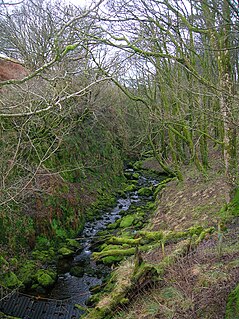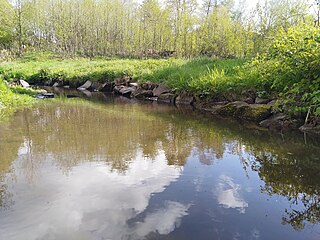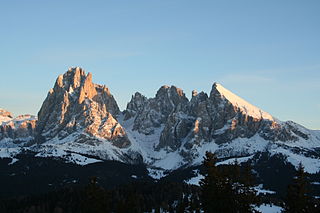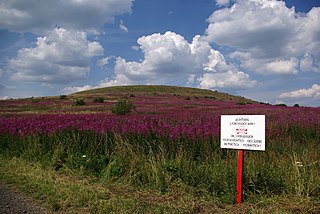
Loch is the Scottish Gaelic, Scots and Irish word for a lake or sea inlet. It is cognate with the Manx lough, Cornish logh, and one of the Welsh words for lake, llwch.

In physical geography, a fjord or fiord is a long, narrow inlet with steep sides or cliffs, created by a glacier. Fjords exist on the coasts of Alaska, Antarctica, British Columbia, Chile, Denmark, Germany, Greenland, the Faroe Islands, Iceland, Ireland, Kamchatka, the Kerguelen Islands, Labrador, Newfoundland, New Zealand, Norway, Novaya Zemlya, Nunavut, Quebec, the Patagonia region of Argentina and Chile, Russia, South Georgia Island, Tasmania, United Kingdom, and Washington state. Norway's coastline is estimated to be 29,000 km (18,000 mi) long with its nearly 1,200 fjords, but only 2,500 km (1,600 mi) long excluding the fjords.

A glen is a valley, typically one that is long and bounded by gently sloped concave sides, unlike a ravine, which is deep and bounded by steep slopes. Whittow defines it as a "Scottish term for a deep valley in the Highlands" that is "narrower than a strath". The word is Goidelic in origin: gleann in Irish and Scottish Gaelic, glion in Manx. The designation "glen" also occurs often in place names.
Firth is a word in the English and Scots languages used to denote various coastal waters in the United Kingdom, predominantly within Scotland. In the Northern Isles, it more usually refers to a smaller inlet. It is linguistically cognate to fjord, which has a more constrained sense in English. Bodies of water named "firths" tend to be more common on the Scottish east coast, or in the southwest of the country, although the Firth of Clyde is an exception to this. The Highland coast contains numerous estuaries, straits, and inlets of a similar kind, but not called "firth" ; instead, these are often called sea lochs. Before about 1850, the spelling "Frith" was more common.

A ria is a coastal inlet formed by the partial submergence of an unglaciated river valley. It is a drowned river valley that remains open to the sea. Typically rias have a dendritic, treelike outline although they can be straight and without significant branches. This pattern is inherited from the dendritic drainage pattern of the flooded river valley. The drowning of river valleys along a stretch of coast and formation of rias results in an extremely irregular and indented coastline. Often, there are naturally occurring islands, which are summits of partly submerged, pre-existing hill peaks.

A geographical pole or geographic pole is either of the two points on Earth where its axis of rotation intersects its surface. The North Pole lies in the Arctic Ocean while the South Pole is in Antarctica. North and South poles are also defined for other planets or satellites in the Solar System, with a North pole being on the same side of the invariable plane as Earth's North pole.

An inlet is an indentation of a shoreline, usually long and narrow, such as a small bay or arm, that often leads to an enclosed body of salt water, such as a sound, bay, lagoon, or marsh.

Turlough Hill, also known as Tomaneena, is a 681-metre-high (2,234 ft) mountain in County Wicklow in Ireland and site of Ireland's only pumped-storage hydroelectricity plant. The power station is owned and operated by the ESB and can generate up to 292 megawatts (392,000 hp) of electricity at times of peak demand.

A body of water or waterbody is any significant accumulation of water on the surface of Earth or another planet. The term most often refers to oceans, seas, and lakes, but it includes smaller pools of water such as ponds, wetlands, or more rarely, puddles. A body of water does not have to be still or contained; rivers, streams, canals, and other geographical features where water moves from one place to another are also considered bodies of water.

In geography, a cape is a headland or a promontory of large size extending into a body of water, usually the sea. A cape usually represents a marked change in trend of the coastline which makes them prone to natural forms of erosion, mainly tidal actions. This results in capes having a relatively short geological lifespan. Capes can be formed by glaciers, volcanoes, and changes in sea level. Erosion plays a large role in each of these methods of formation.

Seaforth Island is an uninhabited island in the Outer Hebrides of Scotland. Unlike many other islands of the Outer Hebrides which are mainly surrounded by open sea, Seaforth Island lies in a narrow fjord-like sea loch named Loch Seaforth, 8 kilometres (5.0 mi) from the open waters of The Minch. There are two different Gaelic names for the island. Mulag is from the Old Norse name Múli, which describes its geographical location, and the other is after the family of Francis Mackenzie, 1st Baron Seaforth, who inherited the island in 1783.

In geomorphology, a col is the lowest point on a mountain ridge between two peaks. It may also be called a gap. Particularly rugged and forbidding cols in the terrain are usually referred to as notches. They are generally unsuitable as mountain passes, but are occasionally crossed by mule tracks or climbers' routes. The term col tends to be associated more with mountain rather than hill ranges. It is derived from the French col from Latin collum, "neck".

U-shaped valleys, also called trough valleys or glacial troughs, are formed by the process of glaciation. They are characteristic of mountain glaciation in particular. They have a characteristic U shape in cross-section, with steep, straight sides and a flat or rounded bottom. Glaciated valleys are formed when a glacier travels across and down a slope, carving the valley by the action of scouring. When the ice recedes or thaws, the valley remains, often littered with small boulders that were transported within the ice, called glacial till or glacial erratic.
John Kay Carmack has been a general authority of The Church of Jesus Christ of Latter-day Saints since 1984. He is currently an emeritus general authority and was the managing director of the church's Perpetual Education Fund from 2001 to 2012.
Historical regions are geographical regions which at some point in time had a cultural, ethnic, linguistic or political basis, regardless of latterday borders. They are used as delimitations for studying and analysing social development of period-specific cultures without any reference to contemporary political, economic or social organisations.
The fundamental principle underlying this view is that older political and mental structures exist which exercise greater influence on the spatial-social identity of individuals than is understood by the contemporary world, bound to and often blinded by its own worldview - e.g. the focus on the nation-state.
A graded shoreline is a stage in the cycle of coastal development characterised by a flat and straight coastline. It is formed under the influence of wind and water from the original bays, islands, peninsulas and promontories. Sand and gravel is carried away and dumped at other locations depending on the direction and strength of sea currents. Typical of graded shorelines are the formation of dunes, wide sandy beaches and sometimes a lagoon or a spit. Where two graded shorelines meet, a headland may form with a sandy reef in the sea beyond it. Parallel to the graded shoreline sandbanks may form as a result of sediments transported away from the shore.

A Kuppe is the term used in German-speaking central Europe for a mountain or hill with a rounded summit that has no rock formation, such as a tor, on it. A range of such hills is called a Kuppengebirge. In geology the term also refers to corresponding stratigraphic forms. The term is similar to the English topographical and geological terms, knoll and dome. It is also analogous to the French word ballon which means a mountain with a rounded summit.

A circumpolar distribution is any range of a taxon that occurs over a wide range of longitudes but only at high latitudes; such a range therefore extends all the way around either the North Pole or the South Pole. Taxa that are also found in isolated high-mountain environments further from the poles are said to have arctic–alpine distributions.

A cirque stairway or sequence of cirque steps is a stepped succession of glacially eroded rock basins. Their individual formation is that of a cirque.
















